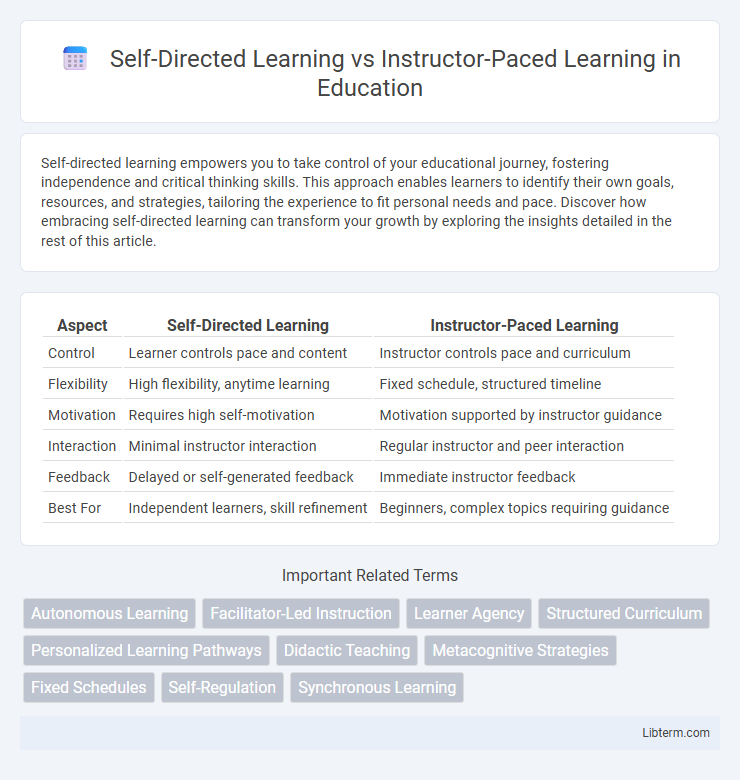Self-directed learning empowers you to take control of your educational journey, fostering independence and critical thinking skills. This approach enables learners to identify their own goals, resources, and strategies, tailoring the experience to fit personal needs and pace. Discover how embracing self-directed learning can transform your growth by exploring the insights detailed in the rest of this article.
Table of Comparison
| Aspect | Self-Directed Learning | Instructor-Paced Learning |
|---|---|---|
| Control | Learner controls pace and content | Instructor controls pace and curriculum |
| Flexibility | High flexibility, anytime learning | Fixed schedule, structured timeline |
| Motivation | Requires high self-motivation | Motivation supported by instructor guidance |
| Interaction | Minimal instructor interaction | Regular instructor and peer interaction |
| Feedback | Delayed or self-generated feedback | Immediate instructor feedback |
| Best For | Independent learners, skill refinement | Beginners, complex topics requiring guidance |
Understanding Self-Directed Learning
Self-directed learning empowers individuals to take initiative in identifying their learning goals, selecting resources, and evaluating progress, fostering autonomy and personalized growth. This approach enhances critical thinking, adaptability, and lifelong learning skills by encouraging learners to engage actively with content at their own pace. Studies show that self-directed learners often achieve deeper comprehension and retention compared to traditional instructor-paced methods, as they tailor their learning processes to personal needs and preferences.
Defining Instructor-Paced Learning
Instructor-paced learning structures educational content with scheduled lessons and deadlines, guiding students through a predetermined curriculum under the supervision of an instructor. This approach emphasizes consistent pacing and direct interaction, ensuring learners progress uniformly and adhere to the course timeline. It is commonly employed in traditional classroom settings and formal online courses, providing clear expectations and accountability.
Key Differences Between the Two Approaches
Self-directed learning empowers individuals to control the pace, content, and timing of their education, enhancing motivation and personalized understanding. Instructor-paced learning follows a structured schedule led by an educator, ensuring consistent progress and immediate feedback within a set curriculum. The primary differences lie in autonomy, flexibility, and the role of the instructor in guiding versus facilitating learner-driven exploration.
Advantages of Self-Directed Learning
Self-directed learning fosters autonomy, allowing learners to tailor their educational journey based on personal interests and pace, which enhances motivation and retention. This approach promotes critical thinking and problem-solving skills by encouraging active engagement and self-assessment. Studies show that self-directed learners often demonstrate higher adaptability and lifelong learning capabilities compared to those in instructor-paced environments.
Benefits of Instructor-Paced Learning
Instructor-paced learning offers structured guidance and timely feedback, which enhances knowledge retention and ensures consistent progress. This method fosters interaction and collaboration, promoting deeper understanding through group discussions and immediate clarification of doubts. It also helps maintain motivation by providing scheduled deadlines and personalized support tailored to learners' needs.
Challenges in Self-Directed Learning
Self-directed learning presents challenges such as the need for strong time management, self-motivation, and discipline, which can be difficult without external structure. Learners may struggle with identifying reliable resources and setting clear goals, leading to potential gaps in knowledge acquisition. Lack of immediate feedback and guidance often results in slower progress and increased frustration compared to instructor-paced learning environments.
Limitations of Instructor-Paced Learning
Instructor-paced learning often restricts individual learner autonomy by following a fixed schedule that may not accommodate diverse learning speeds or styles. This rigid structure can hinder deeper engagement and limit personalized feedback, reducing the overall effectiveness of knowledge retention. Constraints on flexibility and adaptation may lead to decreased motivation and lower academic performance for learners needing more tailored support.
Choosing the Right Approach for Individual Learners
Understanding individual learning styles and goals is crucial when choosing between Self-Directed Learning and Instructor-Paced Learning. Self-Directed Learning offers flexibility, autonomy, and personalized pacing ideal for motivated learners, while Instructor-Paced Learning provides structured guidance, accountability, and real-time feedback beneficial for those who thrive with external support. Evaluating factors such as discipline level, time availability, and preferred interaction style helps optimize educational outcomes by matching the learner with the most effective approach.
Impact on Motivation and Engagement
Self-directed learning empowers learners by fostering intrinsic motivation and active engagement through autonomy and personalized pacing, which enhances retention and satisfaction. Instructor-paced learning can provide structure and clear guidance, beneficial for learners who thrive on external accountability, but may reduce intrinsic motivation by limiting control over the learning process. Research indicates that balancing autonomy with effective instructional support maximizes motivation and engagement across diverse learner profiles.
Future Trends in Learning Methodologies
Self-directed learning leverages personalized technology and AI-driven platforms to empower learners with autonomy and adaptable pacing, fostering critical thinking and lifelong skills. Instructor-paced learning is evolving with interactive virtual classrooms and real-time analytics, enhancing engagement and immediate feedback. Future trends emphasize hybrid models combining self-direction's flexibility with instructor guidance to optimize learning outcomes across diverse environments.
Self-Directed Learning Infographic

 libterm.com
libterm.com